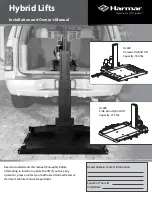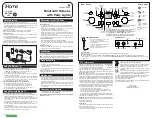
EN
W415-3006 / A / 05.27.21
7
general information
When the appliance is installed directly on combustible material other than wood flooring, the appliance shall be
installed on a metal or wood panel extending the full width and depth.
Solid fuels shall not be burned in this appliance.
1.2 rates and efficiencies
Natural Gas
Propane
Altitude (FT)
0-4,500
Max. Input (BTU/HR)
55,000
53,500
Min. Inlet Gas Supply Pressure
4.5” w.c. (1.12kPA)
Max. Inlet Gas Supply Pressure
7” w.c. (1.74 kPA)
13” w.c. (3.23 kPA)
Manifold Pressure (Under Flow Conditions)
3.5” w.c. (0.87 kPA)
10” w.c. (2.49 kPA)
!
WARNING
• Never obstruct the front opening of the appliance.
• Objects placed in front of the appliance must be kept a minimum of 48” (121.9cm) from the front face of
the appliance.
• Fire risk. Explosion hazard.
• High pressure will damage valve. Disconnect gas supply piping before pressure testing gas line at test
pressures above 1/2 PSIG. Close the manual shut-off valve before pressure testing gas line at pressures
equal to or less than 1/2PSIG (35mb).
• Use only Wolf Steel approved optional accessories and replacement parts with this appliance. Using non-
listed accessories (blowers, doors, louvres, trims, gas components, venting components, etc.) could result
in a safety hazard and will void the warranty and certification.
For your satisfaction, this appliance has been test-fired to assure its operation and quality.
4.3
THIS GAS APPLIANCE SHOULD BE INSTALLED AND
SERVICED BY A QUALIFIED INSTALLER
to conform with
local codes. Installation practices vary from region to region
and it is important to know the specifi cs that apply to your
area, for example in Massachusetts State:
• The appliance off valve must be a “T” handle gas cock.
• The fl exible connector must not be longer than 36”
(91.4cm).
The installation must conform with local codes or, in absence
of local codes, the National Gas and Propane Installation Code CSA B149.1 in Canada, or the National Fuel Gas
Code, ANSI Z223.1 / NFPA 54 in the United States.
The appliance and its individual shutoff valve must be disconnected from the gas supply piping system during
any pressure testing of that system at test pressures in excess of 1/2 psig (35 mb). The appliance must be
isolated from the gas supply piping system by closing its individual manual shutoff valve during any pressure
testing of the gas supply piping system at test pressures equal to or less than 1/2 psig (35 mb). When installed
with a blower or fan, the junction box must be electrically connected and grounded in accordance with local
codes. In the absence of local codes, use the current CSA C22.1 Canadian Electrical Code in Canada or the
ANSI / NFPA 70 National Electric Code in the United States. In the case where the blower is equipped with
a power cord it must be connected into a properly grounded receptacle. The grounding prong must not be
removed from the cord plug.
We suggest that our gas
hearth products be installed
and serviced by professionals
who are certified in the U.S.
by the National Fireplace
Institute
® (NFI) as NFI Gas
Specialists
www.nficertified.org
1.3 general instructions








































